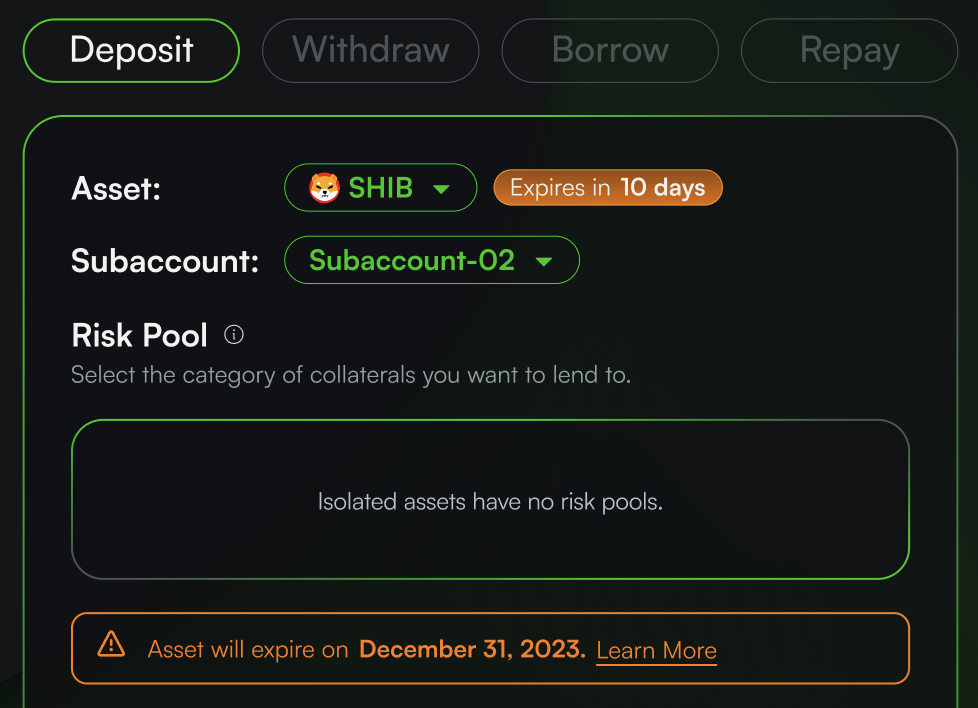Glossary
Subaccount
Subaccounts offer a flexible way to manage your loan positions, allowing for both isolated and cross-collateralization depending on the type of asset. Each subaccount operates independently, providing distinct management of various assets. Additionally, creating a subaccount incurs no gas fees, enhancing the efficiency of managing your financial activities.
Risk Pool
Each risk pool consists of a specific set of assets that can be used as collateral to borrow assets from that pool. Lenders can choose their preferred level of collateral risk and interests for their deposits by selecting the risk pools they want to deposit. Lenders who deposit into higher-risk pools can still earn interest from lower-risk pools.
For example, lenders can deposit their USDC into high-risk pools to access loans backed by riskier assets. Alternatively, they can opt to lend to safe collateral by depositing into low-risk pools.
Risk Grade
Each asset is assigned a risk grade based on a comprehensive risk assessment, indicating its level of risk. For more information on risk assessment, please refer to here. The risk grade determines various collateral asset loan configurations, including borrow APY, Loan-to-Value (LTV) ratios, liquidation settings, and more.
By having a risk grade, Omni is able to list any asset, from popular coins to long-tail assets, providing high asset diversity while ensuring the protocol's safety.
Collateral Type
This determines whether the asset can be used as cross collateral or isolated collateral.
- Cross collateral: allows multiple different assets to support a single loan or multiple loans.
- Isolated collateral: restricts you to using only one type of asset in a subaccount.
Generally, only assets with low risk grades support cross collateral.
E-mode
E-mode is a feature specifically developed to improve borrowing power for those focusing on either a single type of asset or a closely related group of assets. Currently, we offer two variations of E-mode:
- Stablecoins E-mode
- ETH Correlated E-mode
When you enable E-mode for your assets, it could include adjustments to several risk parameters, enhancing your borrowing power. These adjustments could include:
- Collateral Factor
- Borrow Factor
- Liquidation Thresholds (optional)
- Liquidation Bonuses (optional)
- Custom Price Oracles (optional)
To view the currently supported E-mode categories, please click here.
Collateral Value
Collateral value is the total value in USD, of the assets you deposit that can be used as collateral. This value is critical in determining how much you can borrow. The value of your deposited assets as collateral is calculated by:
- Collateral Factor: This is a number between
0and1, acting as a discount on your collateral asset's current price, reflecting the asset's risk level. Higher-risk assets typically have lower collateral factors.
Borrow Value
The borrow value, adjusted by the borrow factor, is used to determine how much of a particular asset you can borrow considering the asset risk.
- Borrow Factor: Also a number between
0and1, inversely applied to the borrowed asset's current price, representing its risk. Higher-risk assets usually come with higher borrow factors.
Health Factor
This metric represents the ratio of your total collateral value (in USD) to your total borrowed amount, including accrued interest. It incorporates the liquidation thresholds of your collateral assets. A Health Factor below 1.0 signals that your loan is under-collateralized, meaning it's at risk of liquidation.
Interest Rate Model
Omni uses a variable interest rate model, known as a linear kink model. Unlike other DeFi Money Market Protocols where rates primarily depend on utilization rates, Omni's rates also consider the risk grade of the collateral asset. Here's how it works:
- Higher Risk, Higher Rate: If the collateral asset is of a higher risk, the interest rate is set higher. This compensates lenders for taking on more risk.
- Lower Risk, Lower Rate: Conversely, a lower risk collateral asset will have a lower interest rate, reflecting its safer nature.
Each market within Omni has its interest rate model tailored with specific parameters that correspond to the risk level of the assets involved.
Expiration date
Certain assets have a set expiration date due to a strategic approach due to the cyclical nature of crypto. It ensures that these assets are periodically reevaluated in line with market dynamics.

- Deposits: If your deposited asset reaches its expiration date and it is not being used as collateral, you retain the ability to withdraw your deposit. However, post-expiration, you will no longer be able to make new deposits of that particular asset into the protocol.
- Collateralized Deposits: If your deposited collateral reaches its expiration date, the loan secured by this asset becomes at risk of liquidation. Therefore, it's crucial to repay these loans before the expiration date.
To view the expiration dates of assets, please click here.
OmniTokens
When you deposit assets into Omni, they are automatically converted into shares of OmniTokens. OmniToken shares represent your proportional claim to the underlying deposits and will be equal to your deposited amount and all interest earned while your tokens are deposited. These OmniTokens are able to be transferred between accounts, and users are able to redeem these tokens for the underlying asset at any time, given there is sufficient liquidity and no account health issues. To do this, simply withdraw your deposits, and the corresponding oTokens in your wallet will be seamlessly burned.
Reserve
The protocol can be configured to have a reserve that is paid a fee for all interest paid by borrowers. This is an optional configuration to the protocol.
Oracles
The protocol most commonly use Chainlink or Band oracles when available, but if unavailable may defer to a Custom oracle that may be a Uniswap V3 oracle implementation or another similar custom oracle.